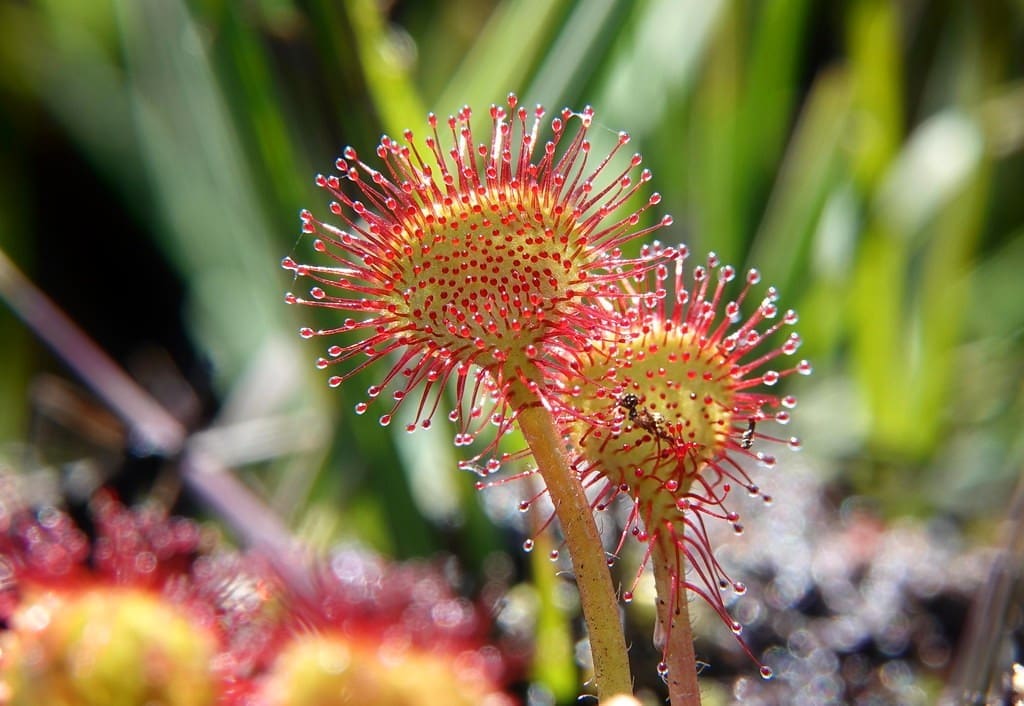
Drosera rotundifolia
Latin name: Drosera rotundifolia
Short name: Dros
Common name: Sundew | Round-leaved Sundew | Common Sundew | Dew Plant | Youthwort
Primary miasm: Tubercular Secondary miasm(s): Syphilitic
Kingdom: Plants
Family: Droseraceae
- Symptomatology
- Remedy Information
- Differentiation & Application
Drosera rotundifolia is a small insectivorous plant found in bogs and marshes across the Northern Hemisphere. It derives its name from the dewdrop-like glands that cover its round leaves, which trap and digest insects. In homeopathy, Drosera is celebrated for its powerful action on the respiratory tract, especially in violent coughs, whooping cough, and laryngeal spasm. Its remarkable affinity for spasmodic affections of the chest and throat make it a cornerstone remedy for coughs of various origins.
Traditionally used in herbal medicine for respiratory ailments, particularly cough, asthma, and bronchitis. It was once a component in medieval expectorant syrups and remains used in some phytotherapeutic respiratory mixtures today.
Proved by Hahnemann and introduced in the Materia Medica Pura. Hahnemann observed its dramatic cough-producing properties. Clinical confirmation arose rapidly during epidemics of pertussis.
- Respiratory tract – especially larynx, trachea, bronchi
- Nerves – vagus nerve, causing spasms
- Muscles of respiration – particularly in the throat and chest
- Eyes – strained from violent coughing
- Gastrointestinal system – secondarily affected by violent emesis from coughing
- Mind – paranoia, delusions
- Open air
- Sitting upright
- Pressure on chest
- Rest
- After vomiting (sometimes temporarily)
- Walking slowly
- Lying down, especially at night
- Talking or reading aloud
- Laughing, singing, or swallowing
- Warm room or bed
- Tobacco smoke or strong odours
- After midnight (especially 2–4 a.m.)
- Cold drinks
- Coccus cacti – Cough with ropy expectoration and morning aggravation
- Pertussin – Nosode for whooping cough, less specific than Drosera
- Corallium rubrum – Cough in rapid, short bursts, worse in cold air
- Ipecacuanha – Cough with persistent nausea and vomiting, less spasmodic
- Antimonium tartaricum – Cough with rattling and weakness, more mucous involvement
- Belladonna – Sudden violent coughing but more congestive and febrile
- Complementary: Nux vomica, Calcarea carb
- Antidotes: Camphora, Vinegar
- Follows well: Aconite in early febrile stage
Drosera represents the violent internal struggle against constriction, both physical and emotional. Its core is spasm and paroxysm—sudden, irresistible, and exhaustive. The body is wracked by dry, tearing coughs; the mind is haunted by suspicion and tension. It is the remedy for the thin, sensitive, consumptive constitution, trapped in a pattern of explosive effort and fearful anticipation. The larynx, the lungs, the psyche—all vibrate with a kind of suffocative tension that seeks release.
- Top remedy for whooping cough with classic barking, choking paroxysms
- Use in laryngeal spasm, especially in tubercular constitutions
- Helpful in chronic coughs that wake after midnight
- Consider in children with violent spasmodic cough and bleeding
- Especially valuable when cough is triggered by speaking or lying down
Cough
- Barking, spasmodic, suffocative
- Worse after midnight
- Worse lying down
- Cough causes vomiting
Throat
- Tickling, rawness, irritation
- Scraping sensation
- Constriction
Mind
- Suspicious, believes he is watched
- Fear of being poisoned
- Irritability after cough
Generalities
- Better in open air
- Worse warmth of bed
- Weakness after cough
- Samuel Hahnemann – Materia Medica Pura: Original proving and cough symptoms
- C. Hering – Guiding Symptoms: Key descriptions of paroxysmal cough and mind symptoms
- William Boericke – Pocket Manual: Practical clinical tips and modalities
- J.T. Kent – Lectures on Homoeopathic Materia Medica: Mental picture and coughing pattern
- John Henry Clarke – Dictionary of Practical Materia Medica: Respiratory focus and repertorial rubrics
- Allen’s Encyclopaedia: Extended proving symptoms and differentiations
